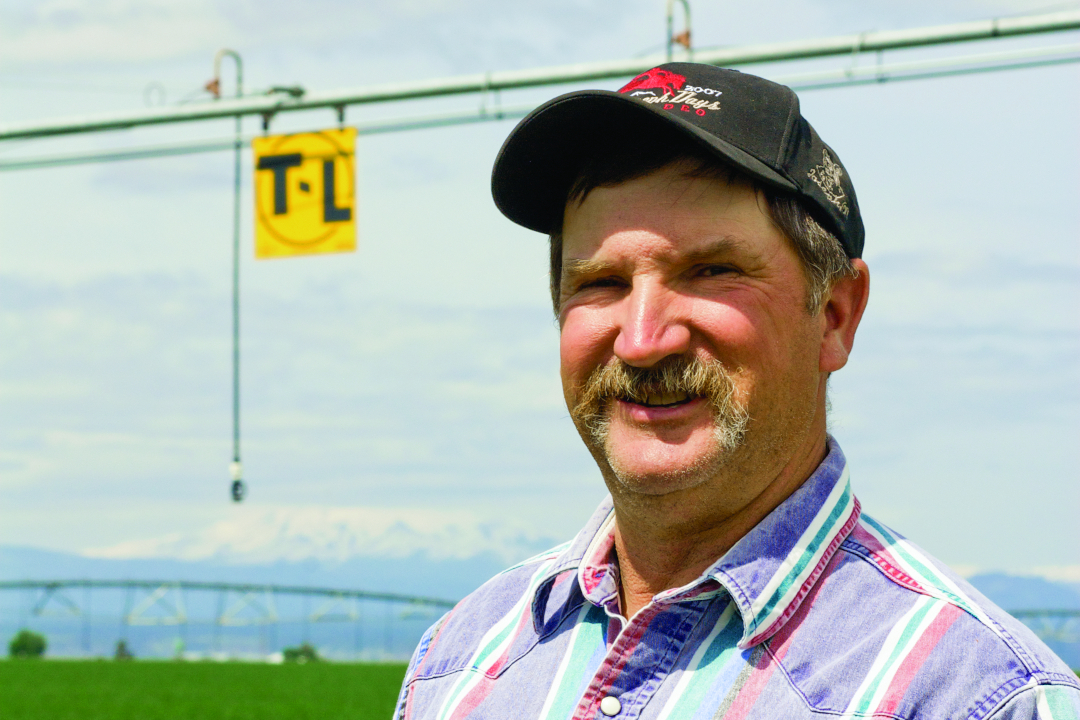Read stories from farmers all around the world and why they chose T-L.
Brad Klann
"Once we started using those T-Ls, the irrigation water started pushing those salts back down and we began get- ting some pretty good crops."
Two big changes in his family’s water management practices come quite readily to Brad Klann’s mind.
His primary crop on 840 acres near Madras, Oregon, is Kentucky Bluegrass seed, rotated with hybrid carrot seed and northern spring wheat, with five years for the grass.
First, in 1970, after years of mostly flood irrigation, his father began putting in a few wheel-lines on the farm, which was then 360 acres in size.
Second, in 1978 his father visited a T-L dealer who thought, “T-Ls were the cat’s meow,” Klann remembers. On the other hand, the local Soil Conservation Service technician warned his father that center pivots would compact and ruin the soil.
Regardless of the advice, his father bought two T-Ls, which were among the first center pivots in the area. Well, who was right, the dealer or the SCS?
“At the time we were having problems with salts being pushed up to the center of the beds,” Klann says. “The salt would kill out the Bluegrass in the bed centers and we couldn’t even get onion seed to sprout.”
“But, once we started using those T-Ls, the irrigation water started pushing those salts back down and we began get- ting some pretty good crops. Now those two center pivots are 31 years old—and I imagine they’ll go another 30-some years.”
Since then, two more T-Ls have been installed as the farm expanded and Brad’s son, Seth, just returned to the farm after college graduation.
There was an initial problem that was easily solved, though. Condensation of water in the original 90-weight oil during the winter could develop in the hubs of these first units that would corrode the needle bearings. However, once that oil was replaced with double-ought grease, Klann has not experienced a single problem.
“All we’ve done is to put on new sprinklers every seven or eight years due to sediment wearing out the nozzles, change tires every dozen or so years, and infrequently change a seal in an orbit motor due to age” he points out.
“The original two sprinklers are still going fine, and probably will for a long time yet.”
He also likes that his T-Ls don’t have high voltage electricity going out to the end towers and all the electric motors that electrically powered systems have. The continuous movement of a T-L doesn’t dig wheel ruts as deeply as the stop-and- go electrics he’s noticed in other fields, either.
Klann’s water comes via a canal from spring-fed reservoirs in the Cascade mountains, 85 miles away. He generally applies the full two-and-a-quarter acre feet of water annually allowed.
Although an inch-and-a-half of water each revolution is his usual application, he says operating a center pivot is nice since he can adjust this watering rate down to a quarter-inch or half-inch as needed.
“Using a center pivot doesn’t halve our water use compared to the other forms of irrigation used around here, but we certainly use a lot less water,” Klann comments.
“However, in a short water year, if we receive only one-and-three-quarters or two acre feet of water, we can still plant 100 percent of our farm. Meanwhile irrigators using other methods may be able to plant only 75 percent of their land.”
Another benefit of running a center pivot is the ease of getting a newly- planted crop established underneath one, he says. This is especially noticeable in minimizing “wind skip” on blustery days. Crop uniformity is improved, too.
“A center pivot sprinkler is also a big labor savings tool. For the last seven years I’ve farmed this 840 acres with just one hired man,” Klann reports. “If there were flood irrigation or wheel-lines to handle, I probably would have had to hire two more people.
“When you figure it out over 30 years, a center pivot is pretty economical. Just the labor savings in a couple of years would make a good down payment on a system or maybe pay it off.” he adds.
Increasing field size to become more efficient is another advantage provided by center pivots, he thinks. Most flood irrigated fields in the area are limited to just ten to 20 acres.
Klann’s bottom line: “What T-L means to us is water efficiency, low maintenance cost, labor savings—and profitability!”

- Products
- Center Pivot
- Crops
- Wheat
- States
- Oregon
- Countries
- United States

- Toll Free 1-800-330-4264
- Main Office 1-402-462-4128
- © 2025 T-L Irrigation
- Sitemap

